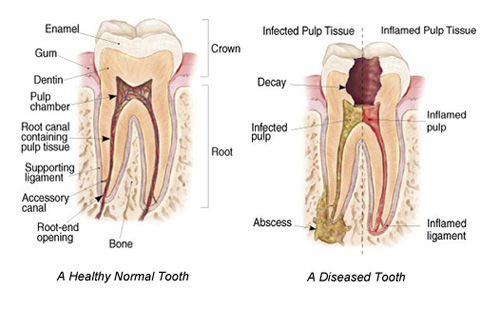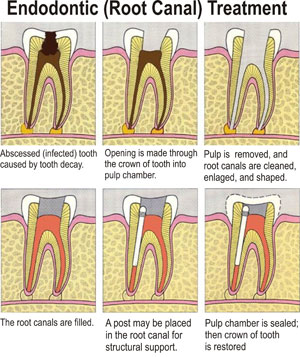972-241-4433
In American Dental Center, our dentists recommend root canal treatment when decay will likely damage or has already killed a tooth. During a root canal, the dentist removes the pulp from the center of a tooth and fills the pulp cavity. This can prevent the development of a painful infection in the pulp that may spread to other teeth. A root canal can also treat an infection that has developed into an abscessed tooth. This procedure can relieve toothache, stop infection, and promote healing.
In addition to dental school Dr. Haghiri has spent years perfecting her root canal therapy skills with the help of the modern technology which exist today, focusing in first op and repairing roots. Here in American Dental Center, our staff will make you feel at home.
 As the procedure goes along, Dr. Haghiri explains every step of the procedure. She believes that the patient needs to be aware of everything that is going on while he/she is being operated on. She will make sure, her patient is in a calm and worry free state before she starts any procedure. Of course, root canal treatment is in fact repair of a damaged teeth and there is always 50% risk of unsuccessful treatment. In every case the Dentist and his or her experience will determine the percentage probability of success of the treatment.
As the procedure goes along, Dr. Haghiri explains every step of the procedure. She believes that the patient needs to be aware of everything that is going on while he/she is being operated on. She will make sure, her patient is in a calm and worry free state before she starts any procedure. Of course, root canal treatment is in fact repair of a damaged teeth and there is always 50% risk of unsuccessful treatment. In every case the Dentist and his or her experience will determine the percentage probability of success of the treatment.
Here in American Dental Center, Dr. Haghiri will evaluate your case thoroughly, and will tell you the success rate of your treatment case.

What Happens During Root Canal Treatment?
A local anesthetic will be given. A sheet of latex called the “rubber dam” will be placed around the tooth to isolate it, hence keeping it clean and dry during treatment. The treatment consists of three or four basic steps, but the number of visits will depend on your particular root canal procedure. Some cases require 2 visits but many are just a single visit. Occasionally 3 appointments are needed.
In any case, it depends on the degree of infection/inflammation and complexity of the required root canal treatment. Our philosophy is that it’s more important to get it done right rather than meet a specific time criteria. Let’s look at the basic steps for nonsurgical root canal therapy.
There are, of course, no guarantees. Root canal treatment has a very high degree of success, up to 90%. We will discuss with you the chances of success before any root canal procedure is performed to help you make an informed decision. If endodontic therapy is unsuccessful or fails you still have options.
Diagnoses and Treat of Pain
Oral pain such as toothaches or cracked / fractured teeth can often be difficult to pinpoint. Because of the vast network of nerves in the mouth, the pain of a damaged or diseased tooth often is felt in another tooth and/or in the head, neck, or ear. our root canal dentists specialize in diagnosing and treating this type of pain.

Treat of Traumatic Injuries
Pulp damage is sometimes caused by a blow to the mouth, and a dentist who specializes in treating these traumatic injuries. For example, a blow to a child’s permanent tooth that is not fully developed can cause the root to stop growing. A procedure called Apexification stimulates bone to be deposited at the end of the root which makes it possible to then save the tooth through a root canal procedure.
Do root canal procedures require multiple visits?
Once Endodontic therapy is completed, your tooth should be examined periodically, Usually every 6 – 12 months. This allows us to make sure the tooth has healed or is healing properly. Since an abscess may take 2 years to heal, our office will reevaluate the tooth for at least 2 years.
Retreatment
Occasionally a tooth that has undergone endodontic, treatment fails to heal or pain continues despite therapy. Although rare, sometimes a tooth initially responds to root canal therapy but becomes painful or diseased months or years later. When either of these situations occur, the tooth often can be maintained with a second endodontic treatment.
Image of Tooth Before Root Canal Treatment


Image of Tooth After Root Canal
“Actual Result May Vary”
